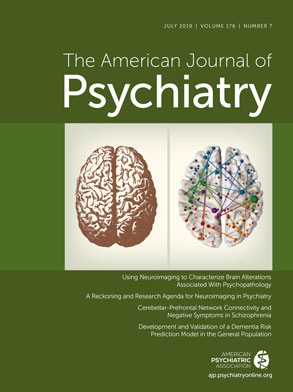T
o the E
ditor: Lawn and colleagues wonder if the results we reported (
1) are biased because the UK Biobank, in the first release of the data, oversampled individuals who are smokers (relative to the full UK Biobank sample). This is indeed a useful aspect of the UK Biobank to draw to wider attention because it may introduce different biases from those known to exist in the sample as a whole. To test this, Lawn et al. propose we repeat our exact analysis strategy in the full data set. Although it is not clear that this is likely to be an issue for the specific study we conducted (unless smoking is associated with higher fecundity), we have now followed their suggestion. In the next paragraph, we restate the main findings we highlighted in the abstract of our article, and we add the results of the analyses of the full data set.
Higher schizophrenia liability in study subjects without manifest disorder was weakly but significantly associated with having more children (B=0.004; 95% CI=0.0016, 0.0061; p=0.0009). The relationship was dependent on sex, with a positive correlation between number of children and liability among females (B=0.007, 95% CI=0.004, 0.010; p=4.5×10−6), whereas among males, higher liability was associated with being childless (odds ratio=0.969; 95% CI=0.958, 0.980; p=2.3×10−8).
In short, in the new analysis, all the effect sizes of the main findings in the full sample lie within the confidence intervals we previously reported, and the statistical significance of those associations is strengthened, as expected given the larger sample size. Our conclusions therefore remain unaltered.
We draw attention to two important differences between our approach and the approach reported by Lawn and colleagues. First, we used the more recent (and better powered) genome-wide association study of schizophrenia to derive large numbers of risk alleles with which to apply a polygenic risk score approach (
2), whereas Lawn and colleagues used a much smaller set of genome-wide significant variants from the smaller study of the Psychiatric Genomics Consortium (
3) for their Mendelian randomization test. Second, and probably more important, we aimed to test the hypothesis that risk alleles persist because they confer reproductive advantages to unaffected people that outweigh the negative effects on fecundity in those with the disorder. That model of persistence predicts association between schizophrenia liability and number of offspring, which is what we tested for. That model does not, however, require any such association to operate along the specific causal pathway that Lawn and colleagues test. As we note in our article (
1), schizophrenia risk alleles are highly pleiotropic (
4); that is, they are known to be associated with increased risk for a range of clinical, cognitive, and behavioral traits, any or all of which might directly or indirectly influence fecundity, as pleiotropic effects of risk alleles might directly affect reproductive biology. Some of these effects may be independent of their effects on schizophrenia liability, some may be consequences of schizophrenia liability, and some may cause schizophrenia liability. The evolutionary model allows for all of these possibilities, whereas the test presented by Lawn and colleagues is of one specific causal relationship, which is sometimes referred to as mediated or vertical pleiotropy (
4). This refers to a pathway, whereby alleles contribute to an underlying quantitative trait we can denote “liability to schizophrenia,” which in turn causes (and is not just associated with) the number of offspring. The analysis presented in Table 1 by Lawn and colleagues suggests that in general, any relationship between schizophrenia risk alleles and number of children does not follow this relatively simple route (although small effect sizes of the magnitude we observed [
1] lie within their confidence interval), and it does not address the wider hypothesis that alleles that increase risk of schizophrenia also influence fecundity.
We agree with Lawn and colleagues’ statement that “whether genetic risk for psychiatric disorders is associated with a reproductive advantage is an important question, as it may explain the persistence of these disorders despite deleterious effects.” In our article, we argued that the (weak) association between schizophrenia liability and number of children in individuals without manifest disorder would not offset the influence of the (much stronger) negative selection effects in those with schizophrenia, and that therefore overall, there is no reproductive advantage conferred by common variant liability. Neither our new analyses nor those of Lawn and colleagues challenge that conclusion. We believe alternative explanations are required for the persistence of common alleles that increase susceptibility to schizophrenia. Based on work we have published elsewhere (
2), we suggest this may occur through the effects of purifying (negative) selection on genetic diversity at particular loci, which in turn allows mildly deleterious alleles to drift to higher frequencies than otherwise expected.

